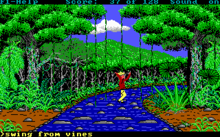Hugo III, Jungle of Doom!
| Hugo III, Jungle of Doom! | |
|---|---|
 DOS cover art | |
| Developer(s) | |
| Publisher(s) | Gray Design Associates |
| Designer(s) | David Gray (coder) |
| Platform(s) | DOS, Windows |
| Release |
|
| Genre(s) | Adventure |
| Mode(s) | Single-player |
Hugo III, Jungle of Doom! is an adventure game released for DOS in 1992. It is the third game in the series, following Hugo's House of Horrors (1990) and Hugo II, Whodunit? (1991).
Plot[]
In the game, the player controls the protagonist, Hugo, who must find spider venom antidote to save the life of his girlfriend, Penelope, who is bitten by a large venomous spider while admiring its web after their plane crashes in the South American jungle. The player must visit a native village and perform a trading quest, including visiting the witch doctor to obtain two necessary items, and cause and effect puzzles (such as using the blow gun the native girl gave you to stun the elephant while using the cage and mouse you got from the witch doctor to scare the elephant away so that it falls and blocks a waterfall, allowing you to cross and access the part of the game where you can obtain the antivenom).
Gameplay[]
The player moves Hugo around by using the arrow keys on the keyboard, and controls his actions by entering commands on the keyboard (or, in the later-released Windows version, one can use the mouse).
Development[]

The first two Hugo games were solo projects by David P. Gray, but with Hugo III, Gray enlisted the help of computer artist Gary Sirois for the game's graphics. Sirois' talent for drawing trees led to the game taking place in a jungle.[1] Having the graphics professionally done increased the production cost and consequently caused the game to be the shortest in the series.[2] Gray has admitted to having confusion in geography, transposing African elements such as an elephant to the South American locale.[2] Hugo's character design has been noted for looking similar to Indiana Jones. Gray maintains this was not intentional, though admits to perhaps a subconscious influence, going on to state that Tarzan was a greater influence.[2] Hugo III also features a few minor technical improvements from the first two, such as a perspective system that changes Hugo's size as he moves deeper into the playing field and a hint system if players get stuck.[2]
References[]
- ^ "Plus XP Interview: David P Gray". Plus XP. 5 February 2010. Retrieved 19 September 2016.
- ^ a b c d "Interview with David P. Gray". RGB Classic Games. 31 March 2008. Retrieved 2 December 2011.
External links[]
- Official site
- Hugo 3: Jungle of Doom at MobyGames
- Hugo 3: Jungle of Doom at GameFAQs
- Classic DOS Games has all of the Hugo III shareware demos for download.
- 1992 video games
- Adventure games
- DOS games
- 1990s interactive fiction
- North America-exclusive video games
- ScummVM-supported games
- Video games developed in the United States
- Video games set in forests
- Video games set in South America
- Windows games